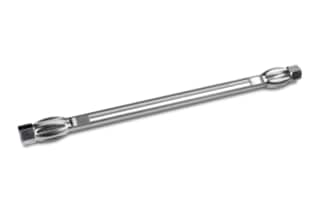
|
Chemistry |
C18 |
|
Separation Mode |
Reversed Phase |
|
Particle Substrate |
Hybrid |
|
pH Range Min |
1 pH |
|
pH Range Max |
12 pH |
|
Maximum Pressure |
6000 psi (415 Bar) |
|
Endcapped |
Yes |
|
Silanol Activity |
Low |
|
Particle Shape |
Spherical |
|
Particle Size |
3.5 µm |
|
Endfitting Type |
Waters |
|
Pore Size |
130 Å |
|
Format |
Column |
|
Surface Area |
185 |
|
System |
HPLC |
|
Particle Technology |
BEH |
|
USP Classification |
L1 |
|
Inner Diameter |
3 mm |
|
Length |
150 mm |
|
Carbon Load |
18 % |
|
UNSPSC |
41115709 |
|
Brand |
XBridge |
|
Product Type |
Columns |
|
Units per Package |
1 pk |

XBridge BEH C18 Column, 130Å, 3.5 µm, 3 mm X 150 mm, 1/pk
While selecting the most suitable column and separation conditions can be extremely difficult, the versatility of the XBridge BEH C18 Column ensures it is easier for you to make this choice. With the XBridge BEH C18 Column, you need not compromise on the sorbent selection and can continue to leverage the flexibility of the column to work under any mobile phase, temperature, and pH conditions necessary to achieve the desired separation
Use optimized approaches to save you time, effort, and expense. Quickly define conditions for rugged method development using the robust XBridge BEH C18 Column that offers wide usable pH ranges. You also get maximum stability under extreme pH conditions with the XBridge BEH C18 Column. These systematic changes over a wide range of mobile-phase pH give you the most control over analyte retention and selectivity.
The XBridge BEH C18 Column simultaneously offers minimum LC/MS bleed while providing increased hydrolytic stability and particle strength using the BEH Technology.
To maximize retention in the XBridge BEH C18 Column, use the ionizable analyte in its most neutral form. An acidic compound, for instance, will have the most retention using acidic mobile phases. Acidic compound retention will decrease as the mobile-phase pH increases. On the contrary, basic compound retention will increase in the same conditions. While acidic mobile phases will provide the least retention, high-pH mobile phases will provide the greatest retention. For a neutral compound, mobile-phase pH has little effect.
You may want to shop for lab equipment and browse through our inventory to see other products such as the XBridge BEH C18 Method Validation Kit, 130Å, 3.5 µm, 3 mm X 150 mm, 3/pk.
What Are The Common Buffers Used in HPLC?
Many different substances are used for buffering in HPLC. Their purpose is to maintain the pH when a small amount of acid or base is added since the retention of ionizable compounds is very sensitive to the mobile phase pH. This makes it necessary to control the pH of the mobile phase by the addition of a buffer. Phosphate and acetate are the most popular buffers for HPLC with UV detection and are particularly useful because they can be used at wavelengths below 220 nm.